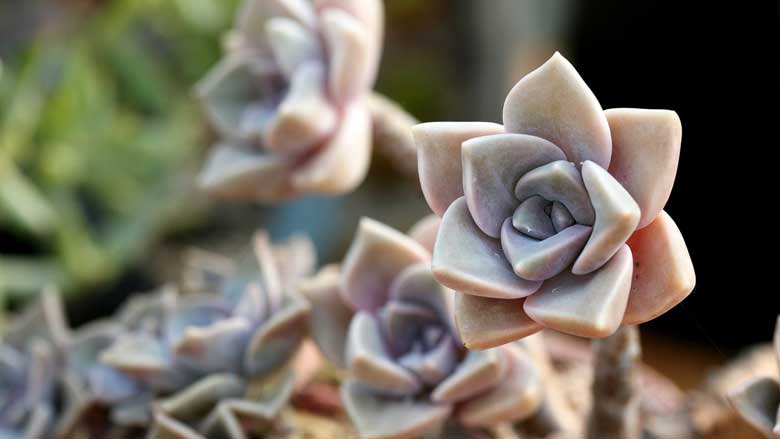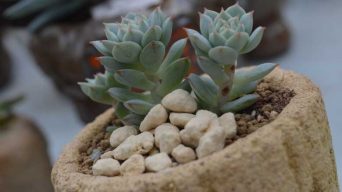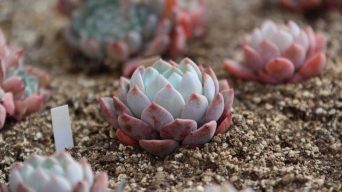Does your succulent have a withering leaf or two? Or how about an overgrown clump of stems that has taken up too much space in your pot?
You’re not alone.
Pruning is the most common way to keep succulents healthy and happy.
Pruning is a necessary part of caring for succulents. Some succulents can grow quickly, and if they are not pruned, they will become leggy and weak.
In this article, we’ll teach how to prune succulents with our easy and complete step-by-step guide so you can maintain a beautiful garden all year round!
Why Should You Prune Succulents
Growing succulents requires maintenance to ensure they are healthy, don’t get too big, and look beautiful.
Pruning succulents is how you will accomplish this task of keeping your plants maintained. Whether you want to maintain the size or shape of a plant or control its growth, pruning is how these goals can be achieved.
Pruning a succulent plant helps to promote growth and can produce a healthier plant. It also helps the plant produce more branches and offsets, resulting in a fuller, bushier look.
When a succulent shows signs of being root-bound, it is time to prune.
If your succulent has roots circling the pot or growing over themselves repeatedly, you should remove some of them for fresh new growth to come out.
Removing rosettes and cutting back stems on a stemless houseplant will encourage more branching and leaf production, resulting in fuller-looking plants. Pruning off older leaves encourages the plant to produce younger ones instead.
Pruning also helps to keep the plant’s overall shape and look. Removing rosettes, stems, or leaves from your overgrown succulent (depending on its growth habit) can help control how tall a specific type of succulent gets.
Succulents that grow upright will be widened when pruned lower down, while those that spread out like a mat become more rounded after being cut back above the ground level.
It is also important to note whether your specific variety should be pruned!
Some types of succulents are better left alone, so researching before attempting to prune them would be wise to avoid harming their health.
This could lead to an early death if they have special requirements much different from others of their kind.
When To Prune Succulents
There is no wrong time of year for pruning succulents, but there are some best times that will allow you to achieve the goals of your succulent pruning plan more easily than others.
For instance, if you want to encourage new growth or maintain size/shape, it might be better to do so before the growing season (early spring) when they begin actively growing again after winter dormancy.
However, check if your plants grow in Spring or Winter and choose the right time of year for your specific variety. Winter growers should be pruned in early spring in the Fall and Spring growers.
If you aim to control a plant’s growth or remove rosettes, stems, and leaves from your succulents, you can do so at any time of the year.
It is good to prune after they have finished blooming since most varieties will set seed during this period for the next season, which could result in fewer flowers being produced once flowering has been completed.
It would be best to remove dead or dying leaves just as they are beginning to turn brown and dry up but before they fall off naturally on their own.
Things To Consider Before Pruning Your Succulents
Before you start pruning your succulents, it is essential to consider a few things.
First off, you should always choose plants that are healthy and vibrant in color.
Next up, please consider whether or not the plant has flowers on it because once those begin to grow, they will sap energy from the leaves, which can cause them to wilt.
Also, consider how old the plant is and what its mature height and width size is like.
Some plants tend to get really tall, while others stay closer to the ground and spread out in multiple directions instead of growing up towards the sun.
This also helps determine where you should cut from on your succulent so that it doesn’t end up ruining any branches or leaves by accident.
Watering your succulents a few days before pruning them can help ensure that their leaves stay healthy and hydrated. The soil should be dry before you start pruning so that the plant can seal off its cuts and prevent any water loss.
If your succulents are in the ground, it is best to wait until after rainstorms or watering events because this will help ensure that they have enough water for days afterward without worrying about overwatering them.
Lastly, always choose a time when temperatures are cool to carry out this task because if it’s too hot outside, the plant might burn and die.
If you’re not sure when it’s an excellent time to prune, then simply do so in the morning or evening instead of during the heat of the day.
How To Prune Succulents: Step-by-Step Guide
Pruning succulents is the process of removing dead leaves, cuttings, or flowers.
This can be done to make room for new growth and will help your plant grow healthier.
To prune them, you need to use a sharp pair of scissors, shears, or even garden clippers for larger succulents like some cacti.
This is a step-by-step guide to pruning succulents.
Step One: Cut Off Dead Leaves and Stems
The first step in the pruning process is to cut off any dead, dying, or desiccated leaves on your succulents.
If you have any living stems that are not attached to a rosette of leaves, these can also be removed for aesthetic purposes.
These pieces will serve for cuttings if you are inclined to propagating succulents.
Step Two: Remove Plantlets (Offsets)
At the base of most rosettes is a small stem that will produce plantlets or baby plants at its leaves’ tips.
These can serve as another propagation method for your new succulent collection, but they must be removed first.
Removing them is simple, just cut the succulent stem on either side of one or two plantlets and let it dry.
Once their roots have started to form, they can be planted in a separate pot with fresh potting mix.
Step Three: Cut Back Stems
Once you have removed all dying or living leaves, dead plantlets, and cuttings from the stems, it is time to prune your succulents.
This step aims to remove any stem that has grown too long for its rosette; if left alone, these can become leggy and weak.
Using sharp pruning shears or even a clean pair of scissors, cut the long stem back to where it meets the rosette.
This will encourage your succulent to produce new growth and leave you with an attractive shape for its leaves.
It is essential to cut them at an angle so that new growth can develop properly.
Step Four: Cut Back Any Other Unwanted Growth
If there are any other stems that you want to remove, do so at this point.
When pruning, try to cut as close as possible where it meets a rosette of leaves; using garden clippers can help with larger succulents like cacti.
This is because leaving stems longer than necessary will encourage your plant to focus its energy on growing these stems rather than its rosette, which will weaken them.
Be sure to cut back any other pieces that you may have removed from the plant; dead leaves and succulent cuttings can be composted or thrown away in trash bags for sanitation purposes.
Step Five: Clean Up
Once you have finished pruning your succulent, give it a good cleaning.
Using clean water and cotton swabs or small brushes, you can wipe any dirt off its leaves without damaging them.
The purpose of this is to remove any bacteria or fungus that can easily infect your succulent if it is left dirty.
Things To Consider After Pruning Your Succulents
After you prune your succulents, there are a few things to keep in mind.
First, don’t water the plant for a few days. This will give the cut end time to dry out and heal. After that, it’s important not to overwater your plant for at least a week.
Second, wait for your succulents to grow new growth before repotting them or planting them outside.
Third, place your plants in an area with bright, indirect sunlight. Avoid direct sunlight, which can cause sunburn.
Fourth, make sure your succulents are in the correct potting substrate. A succulent or cactus soil mix is ideal.
Fifth, keep your plants out of drafts. Succulents are susceptible to cold weather, especially when young.
Last but not least, be patient. After a few weeks of proper care and normal weather conditions, your succulents should be good as new.
How To Prune Succulent Flowers
The best time to prune succulent flowers is right after they have finished blooming. You can also trim them back if you want, but it’s not necessary.
To prune succulent flowers, cut the stem of each flower back to about one-half its length.
You can also use garden shears to cut each flower off at the base. The best way to do this is to snip them right where they branch out or attach another stem/branch.
You can also cut the flower back to a node, where another branch or stem will grow from.
When pruning succulent flowers like this, they won’t regrow until next year. It’s best to do it when they’re done blooming so that way they have a chance to store up energy for next year.
Do not water succulent flowers after you have pruned them, as the cuts will remain open and allow bacteria in if they are watered.
Wait about two weeks before watering again so that way it has time to close over the cut site.
Final Thoughts
Pruning and trimming succulents is a straightforward process as long as you follow these steps.
Succulents are beautiful and require minimal maintenance, making them great for beginners or those who do not have time to spend on their garden.
Succulents are all the rage these days, so it’s no surprise that many people want to start their own succulent garden.
If you have a yard or even just a pot on your balcony, you can grow succulents!
If you’re looking for a new hobby, succulent gardening is an easy and rewarding one to pick up.







